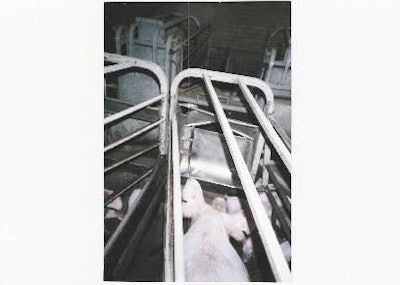
With the increases in litter size seen over recent years, today's sows must produce more milk to rear the extra piglets, and this puts pressure on their daily feed intake. Their appetite decreases in hot conditions, but the fan speeds and openings available for maximum ventilation may not cope with the highest outside temperatures at the height of summer. So an ever-stronger case is being presented for supplementing those efforts by direct cooling of the sow.
The possibilities being investigated include more than methods to cool the air around the sow's area of the farrowing house. Reports last year in at least 2 countries concerned tests of providing the sow with water that had been chilled.
Korean work published in the journal Livestock Science, for example, looked at the effects of chilled drinking water on the performance of lactating sows and litters during periods of high ambient temperatures. The daily temperature inside the farrowing house averaged between 29-30°C while the study was in progress. The water offered to each sow throughout her lactation was either at an uncooled 22°C or chilled down to 15°C or even 10°C.
While obviously expensive to apply in a large herd, chilling the water definitely helped to increase the amount of feed eaten by the sows every day. The baseline for comparison had been that, in measurements taken from farrowing until weaning, sows receiving water at a normal temperature ate less than 4kg daily on average. The extreme of 10°C water raised that for other sows to almost 5.3kg/day. Drinking water at 15°C gave intakes closer to 5.4kg daily.
The impact on water consumption was no less clear-cut, rising from just over 31 litres per sow per day to the higher level of 38-39 litres/day. Calculated milk yields from the sows also showed a benefit from cooling the water. Whereas the control group without cooled water yielded under 6 kilograms of milk per day, the daily amounts for the other groups were up to 7 litres on average. Piglet weaning weights responded by growing from 5.6kg in the control litters to more than 6kg per pig in the others.
Moreover, the researchers in Korea detected shorter intervals between weaning and next oestrus in sows receiving cool water. A similar benefit to the breeding herd's reproductive cycle has been described in Queensland, Australia. During a trial in the Australian summer of 2005/06, sows receiving chilled water in lactation were re-mated more quickly after weaning.
Monitoring in Queensland farrowing houses had already indicated possible trouble when a previous summer's results showed the temperature of drinking water could reach 40°C. The follow-up trial at the University of Queensland's own unit found a summertime maximum of 38.5°C despite good insulation and installation. Any time that air temperatures entering the house exceeded 30°C, even an industrial cooler and insulated supply lines struggled to keep the water down to the target maximum of 20°C. In fact the comparison became between an average of almost 27°C for uncooled water and nearly 21.5°C for the flow at the drinker after cooling.
Feed and water intakes improved nevertheless, by 4% and 17% respectively. Piglets weaned at 26 days old were about 2% heavier from the cooled-water sows. An apparent improvement in their survival rates up to weaning was even more striking. Some 10% of piglets were lost in non-cooling pens compared with only 7.5% where the sows' water had been cooled.
Such results indicate that the payback could compensate for the cost of cooling the water and delivering it through protective pipes, although there will be obvious differences in expense according to system. Equally, setting the Korean and Australian results side by side suggests that the target temperature for the drinking water should be considered. The uncooled water in Korea and the chilled water in Australia were at an almost identical temperature. They gave comparable figures for the daily water intake per sow (31.2 litres against 34 litres) while disagreeing over feed intake per day (3.82kg against 5.87kg). From the Korean data, however, there may be further gains from chilling the sows' drinking water down to 15°C in summer if the extra reduction can be done at an affordable cost.
Perhaps, on economics, it might be better to look first at cooling the floor rather than the water. Chinese agricultural engineers have entered the discussion over climate control in pig-houses by proposing the circulation of water through underfloor pipes to reduce the temperature of the pig's lying area in the summer months. It need not be expensive, they insist. The water for cooling could be stored underground and the pump and pipework used for heating in winter.
Installations tried over the past 10 years have shown most advantage in open-sided housing where more conventional cooling by fans and wet pads may be difficult to apply. In one instance the floor temperature was kept below 26°C even when the outside climate heated up to a mid-afternoon peak of 34°C. PIGI

















